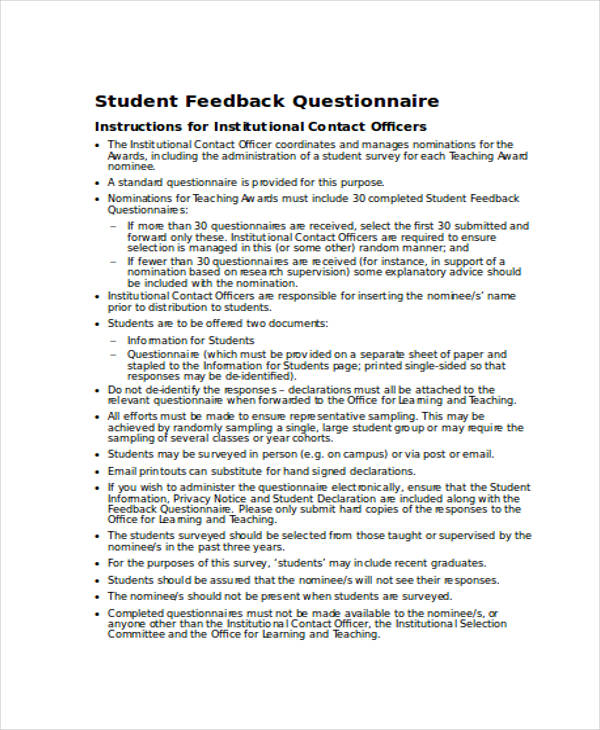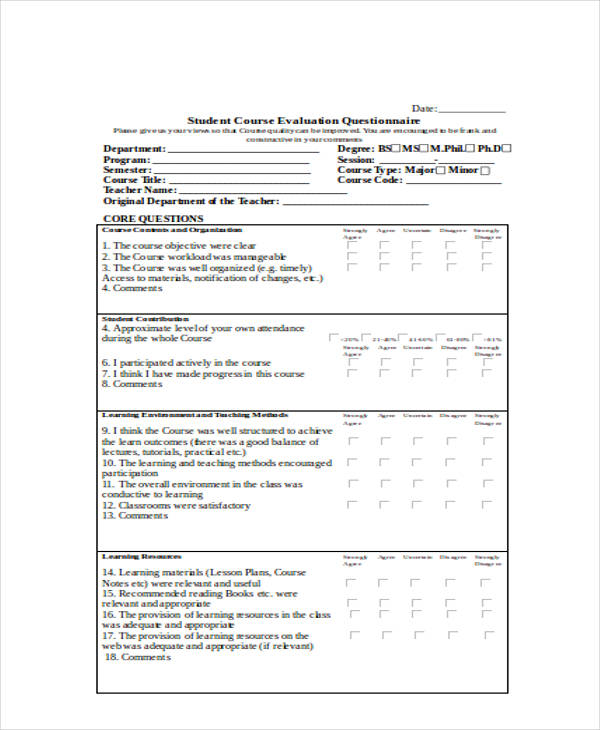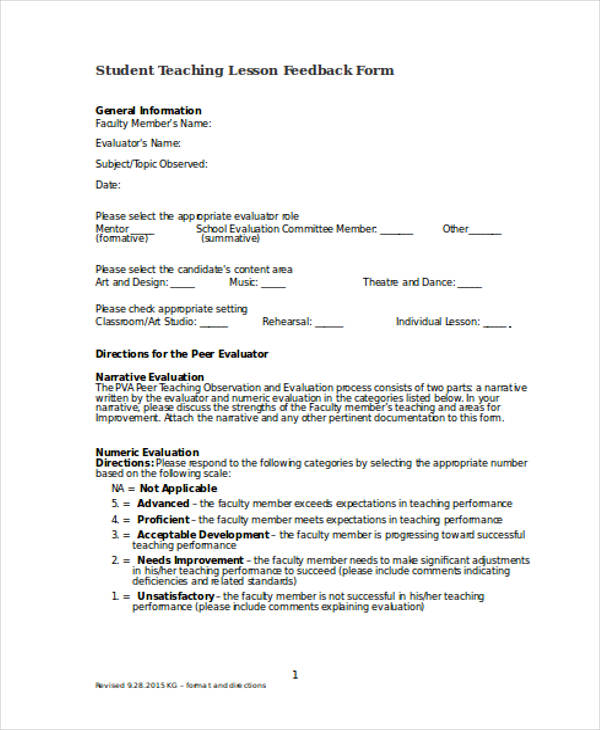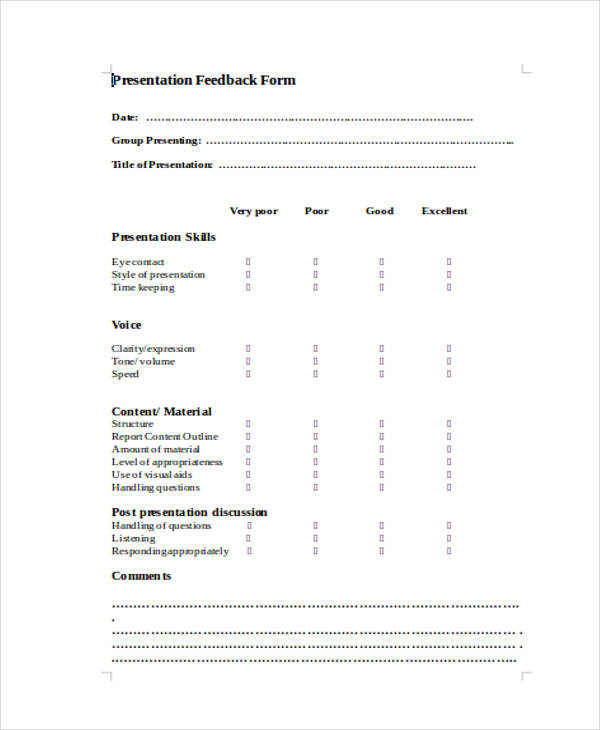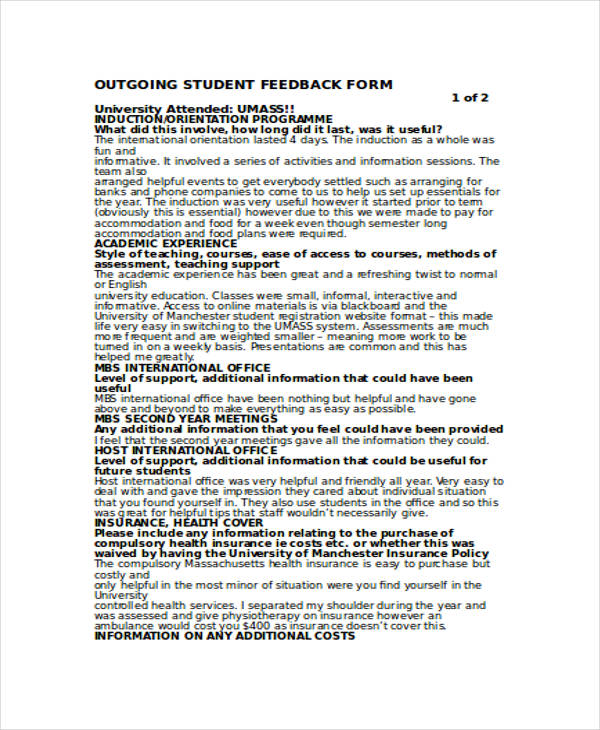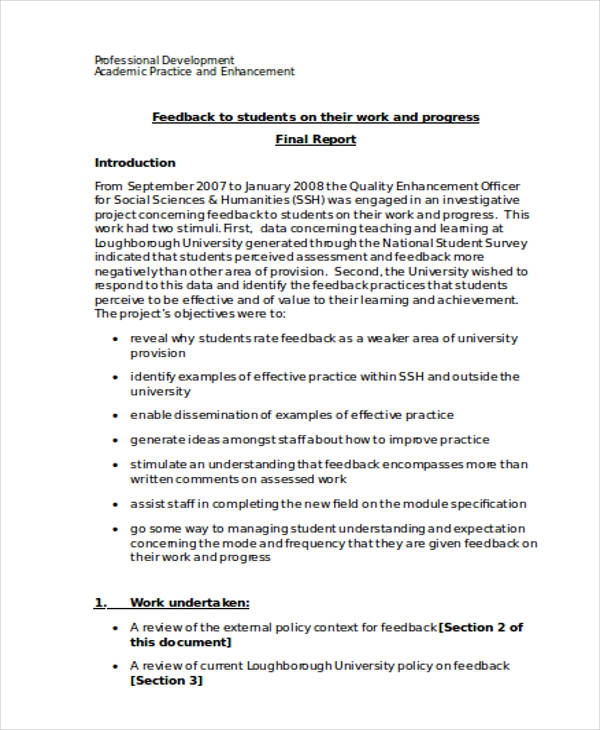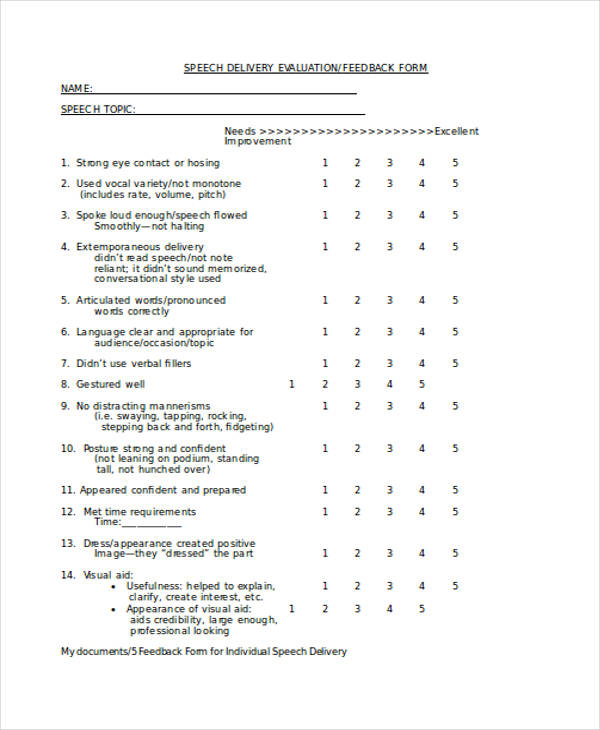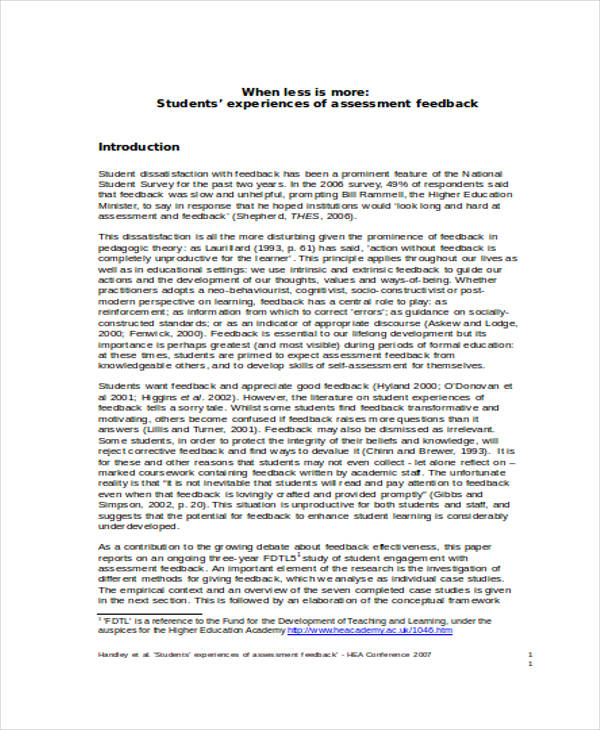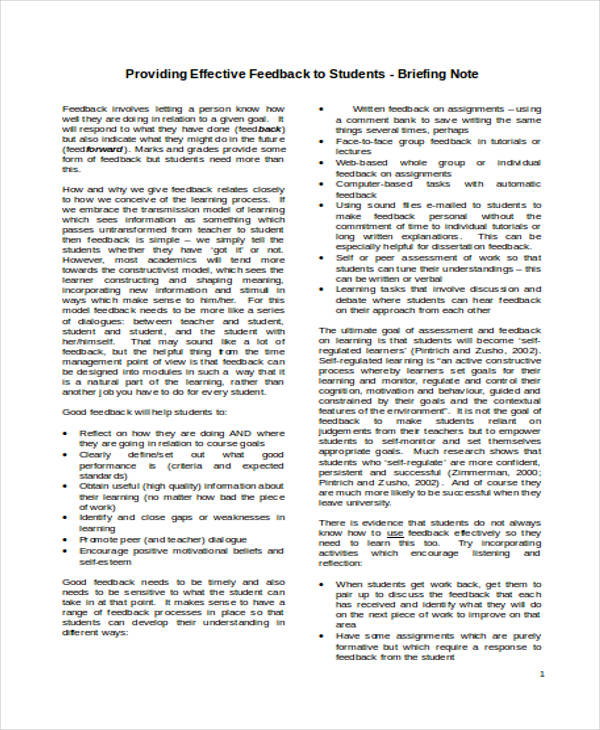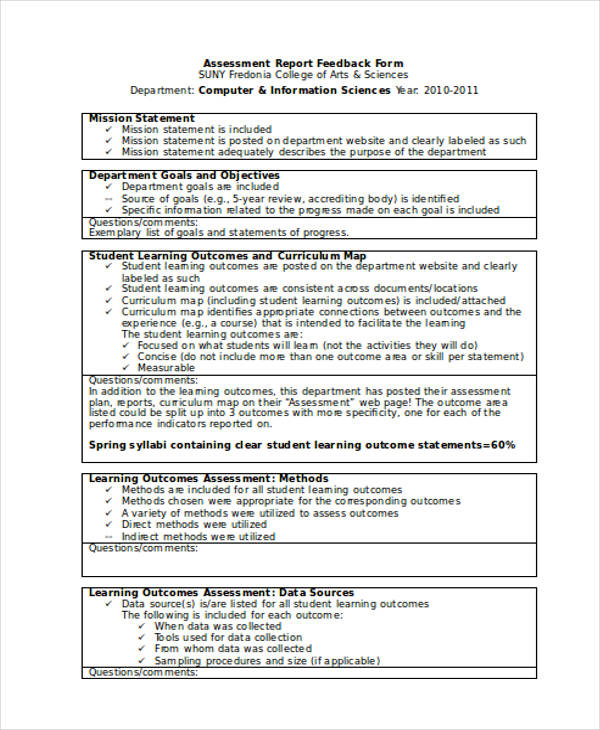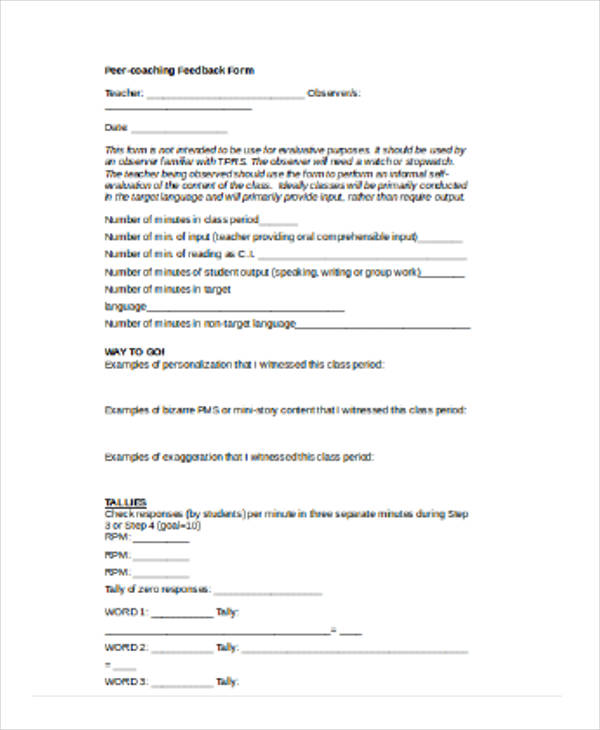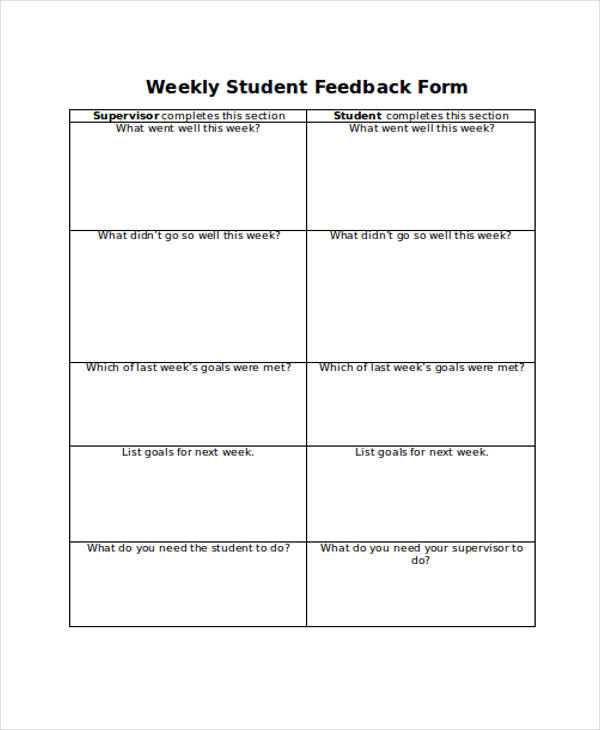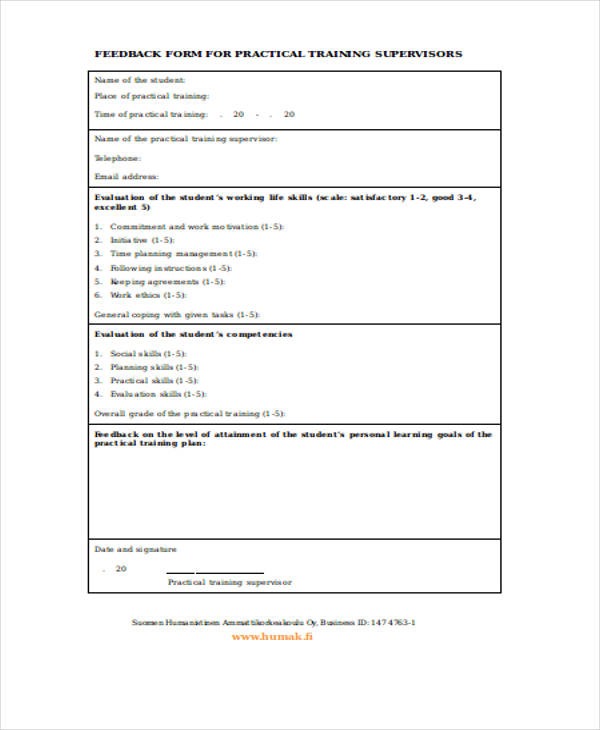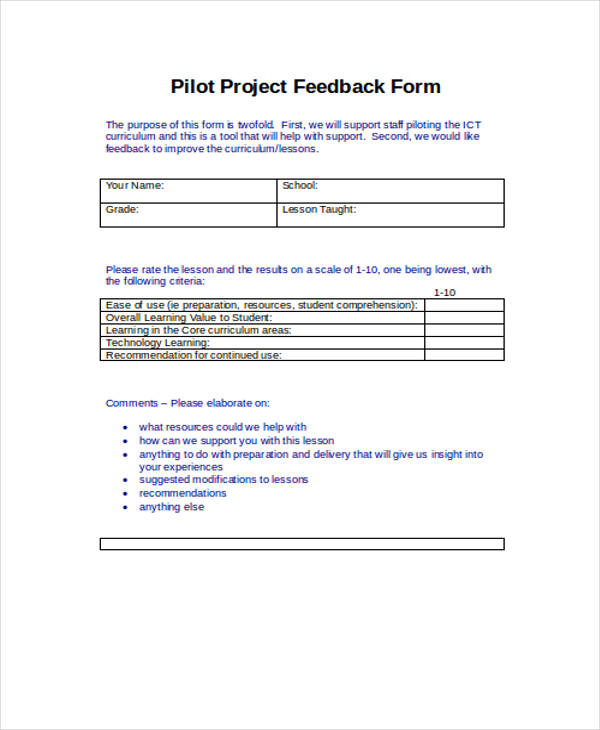A Student Feedback Form is essential for gathering valuable insights from students to improve teaching methods and overall learning experiences. In this guide, we’ll explore the best practices for creating a feedback form that captures essential student feedback. You’ll find examples and templates, ensuring that your form is not only easy to use but also optimized for clear, actionable results. Whether you’re designing a general Feedback Form or a more targeted Training Feedback Form, this guide will help you develop an effective tool for evaluation.
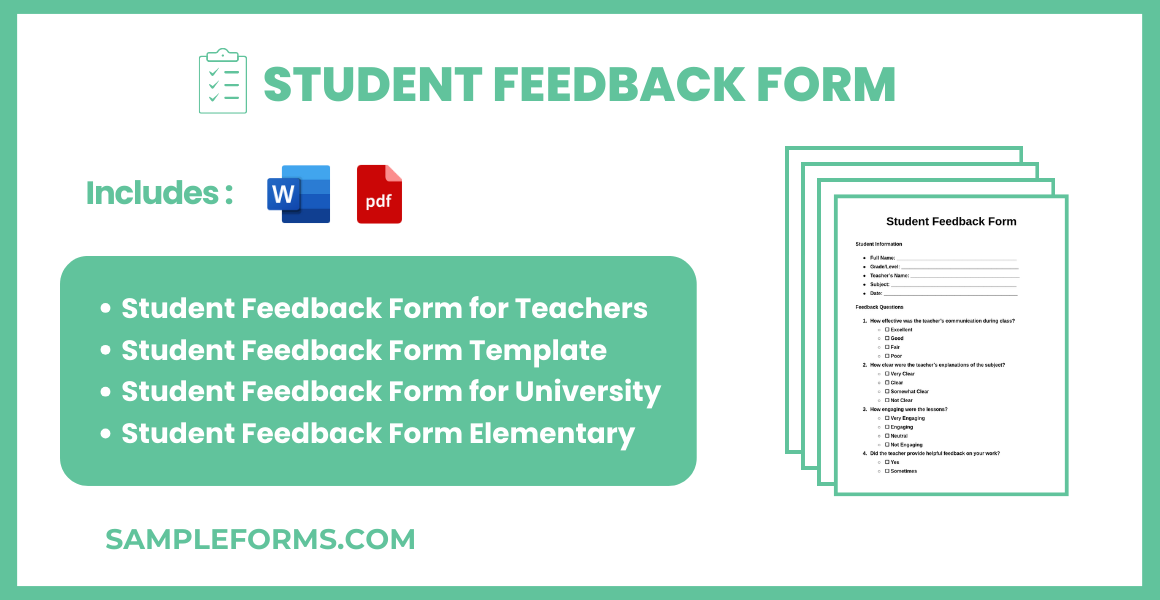
What is Student Feedback Form?
A Student Feedback Form is a structured document used by educators to collect students’ opinions on course content, teaching effectiveness, and overall experience. It helps teachers improve their methods and students’ learning experiences. A well-structured Feedback Form includes questions about course materials, instructor performance, and classroom engagement, providing actionable insights. This form is used in various educational settings to enhance student satisfaction and learning outcomes.
Student Feedback Format
Student Information
- Full Name: ________________________________________
- Course/Subject: ____________________________________
- Instructor’s Name: __________________________________
- Date: ____________________________________________
Feedback Questions
- How would you rate the overall quality of the course?
- Excellent / Good / Average / Poor
- How effective was the teaching method?
- Very Effective / Effective / Neutral / Ineffective
- Were course materials clear and useful?
- Strongly Agree / Agree / Neutral / Disagree
- What could be improved? ___________________________________________
- Additional Comments: ______________________________________________
Student Signature
- Signature: _________________________________________
- Date: _____________________________________________
Student Feedback Form for Teachers

A Student Feedback Form for Teachers gathers feedback on teaching effectiveness, communication, and classroom management. It helps teachers improve their methods based on student input, similar to a Parent Feedback Form for assessing school performance.
Student Feedback Form Template
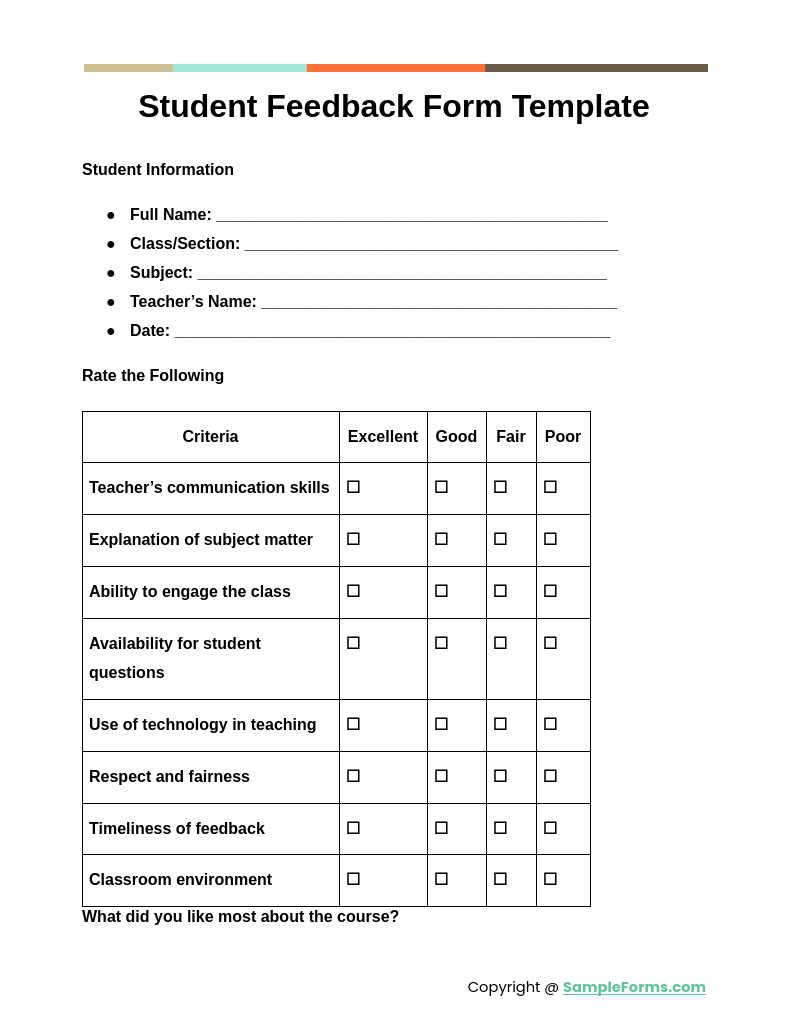
A Student Feedback Form Template provides a structured, customizable format for collecting student feedback on courses or instructors. It works similarly to a Employee Feedback Form, focusing on both course content and teaching quality.
Student Feedback Form for University
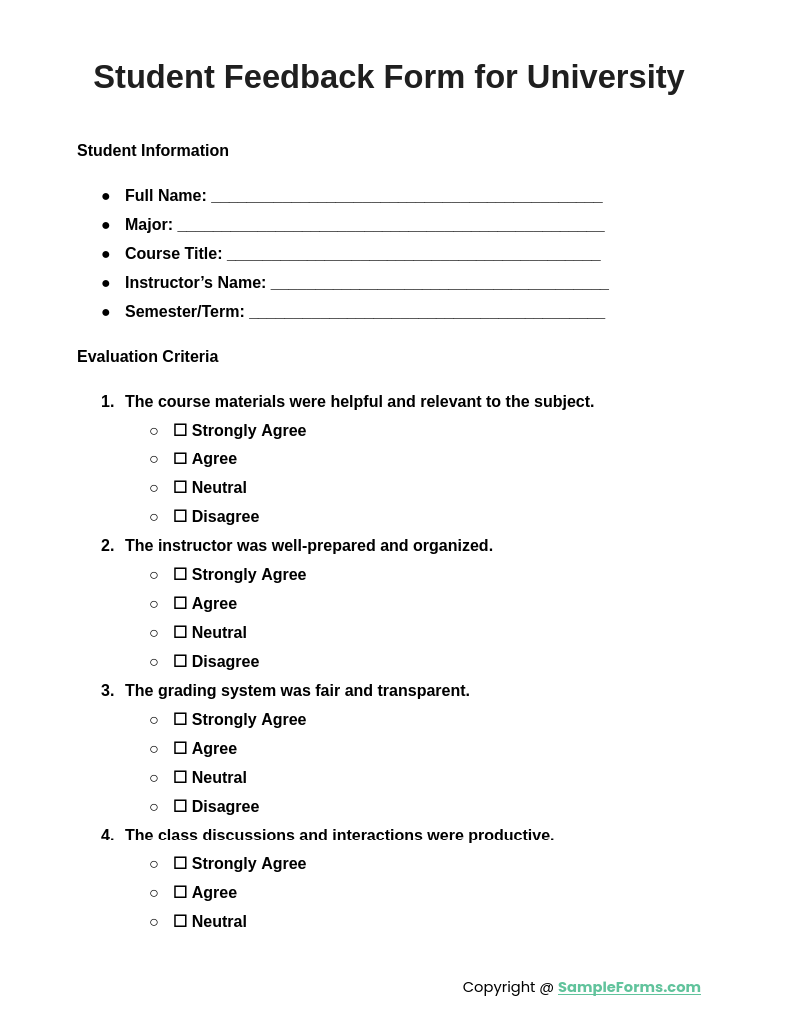
A Student Feedback Form for University helps assess the effectiveness of university courses, instructors, and learning environments. It’s crucial for maintaining academic standards, much like a Customer Feedback Form helps businesses improve services.
Student Feedback Form Elementary
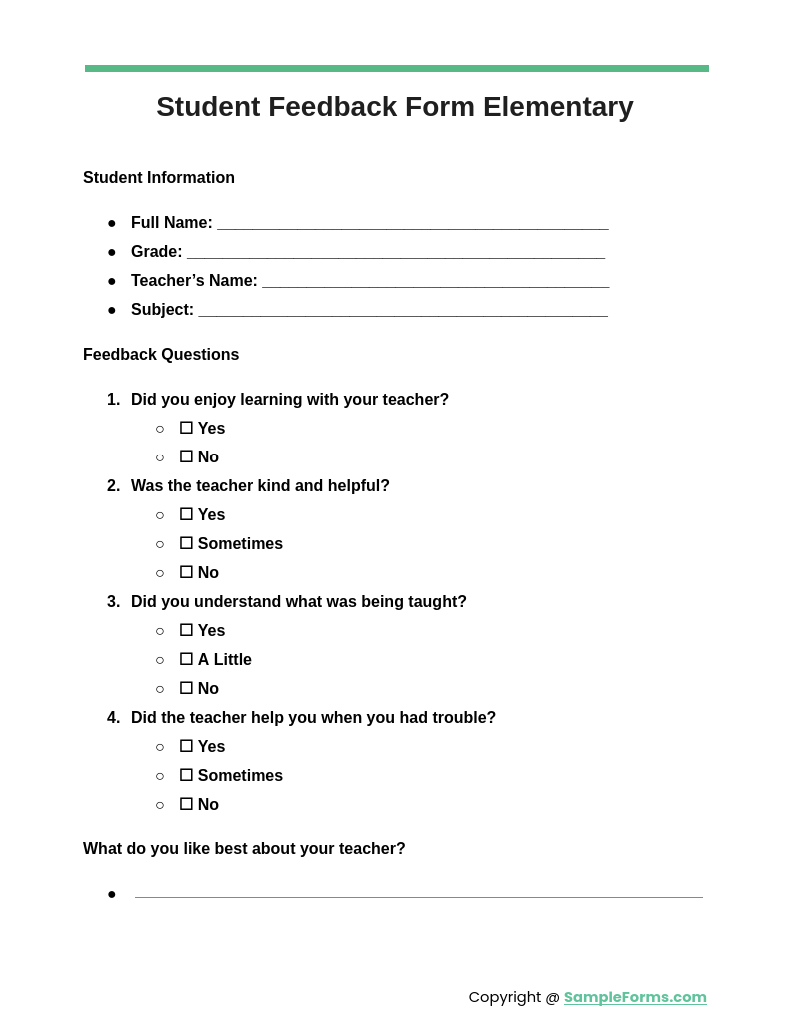
A Student Feedback Form Elementary is designed to capture younger students’ opinions on their learning experience, ensuring better teaching methods. It functions similarly to a Service Feedback Form for evaluating service quality and satisfaction.
Browse More Student Feedback Forms
Student Feedback Questionnaires
Sample Student Feedback Questionnaire
Core Questions Student Feedback Questionnaire
Student Lesson Feedback Forms
Student Teaching Lesson Feedback Form
Student Presentation Feedback Form
Student Group Presentation Feedback Form
Student Formal Presentation Feedback Form
Outgoing Student Feedback Form
Sample Outgoing Student Feedback Form
Student Work Feedback Form
Student Work Progress Feedback Form
Student Education Feedback Forms
Student Education Visits Feedback Form
Student Speech Feedback Form
Student Speech Delivery Feedback Form
Student Employment Feedback Form
Free Student Employment Feedback Form
Student Experience Feedback Form
Student Experience Assessment Feedback Form
Student Effective Feedback Form
Student Providing Effective Feedback Form
Student Report Feedback Form
Student Assessment Report Feedback Form
Student Coaching Feedback Form
Student Peer Coaching Feedback Form
Weekly Student Feedback Form
Sample Weekly Student Feedback Form
Student Practical Feedback Form
Student Practical Training Feedback Form
Student Project Feedback Form
Pilot Student Project Feedback Form
Student Meeting Feedback Form
Student Meeting Feedback Form Example
What should be included in a student feedback form?
A Student Feedback Form should include questions that assess teaching effectiveness, course content, and learning experience, similar to a Teacher Feedback Form.
- Course Content: Evaluate the relevance, clarity, and usefulness of the materials covered.
- Instructor’s Teaching Style: Assess the instructor’s clarity, engagement, and delivery.
- Classroom Environment: Ask about the learning environment and support.
- Student Engagement: Inquire how well the student felt engaged during the course.
- Suggestions for Improvement: Include space for students to suggest improvements.
How to create a feedback form for students?
To create a Student Feedback Form, you need to structure it to evaluate key aspects of learning and teaching, much like a Workshop Feedback Form.
- Determine Goals: Define what you want to learn from the feedback.
- Choose Question Types: Use a mix of multiple-choice, rating scales, and open-ended questions.
- Organize the Form: Divide the form into sections (e.g., course content, instructor, environment).
- Test the Form: Review the form for clarity and ensure it’s easy to understand.
- Distribute: Provide the form in class or via an online platform.
How to write a student feedback?
Writing a Student Feedback requires constructive insights focusing on improvement and strengths, similar to a Course Feedback Form that highlights strengths and areas to improve.
- Start with Positives: Highlight what the student excelled in (e.g., participation, curiosity).
- Be Specific: Provide concrete examples of the student’s performance.
- Offer Suggestions: Give actionable steps for improvement.
- Balance Criticism with Praise: Ensure criticism is constructive and paired with positive reinforcement.
- Be Encouraging: Motivate the student to continue improving and exploring their potential.
How do you write positive remarks for students?
Writing positive remarks for students involves highlighting their strengths and efforts in learning, similar to how an Interview Feedback Form balances positive comments with recommendations.
- Acknowledge Strengths: Start by noting the student’s specific strengths (e.g., leadership, creativity).
- Mention Improvements: Comment on how they have improved over time.
- Highlight Participation: Praise their active participation in discussions or projects.
- Appreciate Attitude: Acknowledge their positive attitude toward learning.
- Encourage Future Growth: Motivate them to continue excelling and pushing their limits. You may also see Manager Feedback Form
How do you write negative remarks for students?
Negative remarks for students should focus on areas for improvement, much like a Teaching Feedback Form highlights weaknesses with suggestions for growth.
- Be Specific: Identify exact areas where the student is struggling (e.g., organization, participation).
- Offer Constructive Feedback: Pair criticism with actionable suggestions for improvement.
- Be Honest but Kind: Deliver criticism with empathy, avoiding harsh language.
- Highlight Some Positives: Mention what the student does well alongside the negatives.
- End on an Encouraging Note: Encourage the student to improve and offer support. You may also see Feedback Form for Parents
Components for Student Feedback
Any member of the faculty can draft and make a feedback form, however, only few know how to target an effective feedback. Here are the main components which are vital in a student feedback form:
The form should have an objective. If the form is for a workshop or for counselling feedback, the statements written on it should be factual and should be based on the actual descriptions of the event. A Workshop Feedback Form will contain the ratings for the emcee, and the training sessions, while a Counseling Feedback Form will consist of the ratings for the impact of the counselor to the students. You may also see Event Feedback Form
The areas should not be generalized. The form should contain the specific areas to be evaluated by the students. For example, when creating a rating for the location of a meeting, the form should specify values such as the location’s appropriateness to the subject, the probable distractions and noise, and if the location helped the students provide ideas for the agenda. You may also see Nursing Feedback Form
The form needs to focus on changeable entities. There are traits that a student cannot change due to his cultural beliefs and other factors that affect his life. However, there are also changeable behaviors found in every person. By using a Student Coaching Feedback Form, the teacher will be able to know the student’s weakness and have a chance to help the student face them.
Construction of new ideas should be the goal of the feedback form. Overall, the form should have a positive outlook despite several details which can be considered as a negative feedback. The ratings are useful in creating an outline of ideas and references. You may also see Coaching Feedback Form
Tips for an Effective Feedback Form
- Organize your form. Make sure that you are not mixing one factor into another. Identify what you want the students to rate, and group the similar ones together.
- Use field labels. When your questions on the form have already been grouped, separate these sections with the help of field labels. The instructions on how to fill out and rate the feedback may also be inside a box for every section to emphasize what needs to be done. You may also see Conference Feedback Form
- Limit mandatory fields. People are born to choose, therefore, it will not be helpful if feedback form consists dozens of sections where a student is required to answer and give reasons for his choices. Limit the compulsory reasoning areas into one or two sections, so that conducting the evaluation will not consume too much time.
- Use a rating scale. This will help the students decide faster than requiring them to write their reasons for rating an event or a subject. Most rating scales use the terms “Satisfactory” and “Unsatisfactory”.
- Construct a comment area. At the bottom of the form, there should be an ample amount of white space for the comments and suggestions of the student. However, avoid making this section a requirement to fill out since not every student can easily open up his thoughts and ideas. You may also see Presentation Feedback Form
How do you structure a feedback form?
A feedback form should be structured clearly with specific sections, like a Product Feedback Form, including rating scales, open-ended questions, and areas for suggestions to gather comprehensive feedback from respondents.
How do you give constructive feedback to students?
Constructive feedback helps students improve by focusing on strengths and offering guidance, similar to a Faculty Feedback Form, balancing positive remarks with actionable suggestions for growth in performance.
What are sentence starters for student feedback?
Use sentence starters like “You have shown great improvement in…”, “I noticed you excel at…”, or “You might work on…” for clear, effective feedback, much like in an Exam Feedback Form.
What questions to ask students who are struggling?
Ask students questions like “What challenges are you facing?”, “How can I assist you?”, and “What resources could help you?” These are similar to questions in a Meeting Feedback Form aimed at solving issues.
How to write a good review for a student?
A good student review highlights their strengths, acknowledges growth, and offers constructive suggestions for improvement, similar to how feedback is provided in a Demo Feedback Form for improvement.
What does a good feedback form look like?
A good feedback form is clear, concise, and user-friendly, like a Project Feedback Form, with specific questions and open-ended sections for more detailed input, ensuring thorough responses.
What are the 3 C’s of feedback?
The 3 C’s of feedback are Clarity, Constructiveness, and Consistency, much like the principles in a Real Estate Feedback Form, ensuring effective communication and actionable guidance.
How do you write a positive note for a student?
Write a positive note by acknowledging the student’s achievements and growth, like a Camp Feedback Form, encouraging them to continue their efforts and maintain progress in specific areas.
What should be included in a feedback report?
A feedback report should include observations, strengths, areas for improvement, and actionable suggestions, similar to a Performance Feedback Form, to guide future growth and performance.
What 3 things should feedback identify?
Feedback should identify strengths, areas for improvement, and actionable next steps, like in an Open House Feedback Form, providing a balanced, constructive approach to ensure progress.
In conclusion, a Student Feedback Form is a vital tool for assessing teaching effectiveness and improving the educational experience. By using samples, forms, and letters provided in this article, educators can collect valuable insights and enhance their methods. This form ensures that students’ voices are heard, leading to better learning outcomes. Whether used in universities or schools, a Observation Feedback Form helps track progress and identify areas for growth.
Related Posts
-
FREE 6+ Market Research Forms in PDF | MS Word
-
FREE 3+ Feedback Observation Forms in PDF | MS Word
-
Classroom Observation Form
-
Behavior Observation Form
-
FREE 32+ Different Formats for Feedback Forms in PDF | Ms Word | Excel
-
FREE 11+ Property Feedback Forms in PDF | Ms word
-
FREE 11+ Observational Feedback Forms in PDF | MS Word
-
Nursing Feedback Form
-
Form for 360 Degree Feedback
-
FREE 10+ Feedback Forms Aimed at Doctors | PDF
-
FREE 11+ Demo Feedback Forms in PDF | MS Word
-
FREE 11+ Exam and Test Feedback Forms in PDF | Ms Word
-
FREE 10+ Medical Feedback Forms in PDF
-
Induction Feedback Form
-
Coaching Feedback Form

